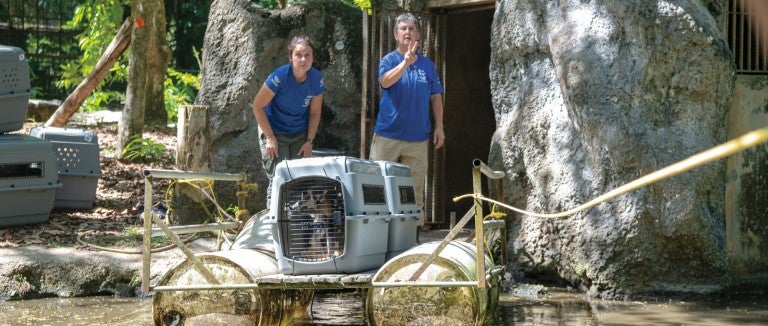Nineteen strangers huddled together, smiling for a group photo. Many had only met that day. But they’d come together for one mission: to rescue over 700 wild animals from a Puerto Rican zoo—closed to the public since hurricanes battered the island in 2017—and a government-run detention center used to house animals seized from the illegal wildlife trade. It was the “largest move of wildlife in modern U.S. history,” Pat Craig, founder of Colorado-based Wild Animal Sanctuary, told NBC News.
Led by Wild Animal Sanctuary, the team included the Humane Society of the United States and Team Rubicon, a veteran-led organization providing disaster relief. They worked long, hot days removing animals from their enclosures and preparing them for transport to new homes. Craig’s team arranged transport for the largest animals—such as big cats, hippos, an elephant and a rhinoceros—before HSUS staff arrived in mid-May.
“On day one—the day we took that picture—nobody knew anybody’s names,” says Dave Pauli, HSUS wildlife conflict program manager. “And by day nine, we knew how many grandchildren we have.”
This newly forged kinship helped the groups pull off a challenging rescue—not only because of the sheer number of animals, but because of their conditions. Caregivers continued to provide for the animals after the zoo closed, sometimes using their own money to buy supplies, and deserve “huge credit” for doing the best they could with limited resources, says Pauli. Still, most animals showed signs of malnourishment, and some showed signs of severe stress. The animals weren’t given birth control or sexually segregated, so many of their populations were “exploding,” Pauli adds. “Most zoos might have six or seven of some species. They had groups of 50 and 75,” he says.

The zoo’s lemurs, who once had free rein of an island, were confined to a cramped building on the island when the surrounding moat’s water level dropped. They had no access to fresh air, says Pauli. “It’s all concrete, no climbing trees, no swinging ropes.” The team found 19 lemurs in two small cages; females even gave birth in these bleak conditions. The animals were fed once a day from a single tray, creating competition for food and leaving them “very skinny,” says Randi Salisbury, senior animal caregiver at Black Beauty Ranch, who led the primate rescue efforts.
The tight space made rescue efforts difficult. The team’s usual transfer cages wouldn’t fit inside the building, so they improvised, using airline crates to catch the lemurs one at a time. They then placed the crates on a raft and pulled it across the shallow moat with rope. It took almost three days to rescue every individual.
Even after all the animals had been removed, there were hurdles. Eight rats and 23 hedgehogs were unable to depart due to flight delays and needed temporary housing. Pedro Cerame, an HSUS senior executive assistant who has worked on various initiatives in Puerto Rico, contacted Santuario de Animales San Francisco de Asís. “They willingly made space for these tiny guests,” he says. Cerame helped coordinate for eight rescued street dogs to join the flight with the hedgehogs and rats, who went to the MSPCA in Boston. The dogs traveled to a Maryland rescue to find new homes.
In addition to helping on the ground, Black Beauty Ranch agreed to provide lifelong care for 23 animals: four emus (tragically, one emu died of cancer shortly after arriving at the HSUS sanctuary), four rhesus macaques, two coatimundis, two llamas, one ostrich and 10 lemurs, including two babies. In Texas, the sanctuary’s facilities team baby-proofed the lemurs’ enclosure as they prepared for the new arrivals.

On May 29, a transport flight took off for Dallas with 296 animals on board. Sanctuary staff eagerly awaited the animals who would call Black Beauty Ranch home. Storms delayed the flight, but eventually the plane landed. Working in the rain, responders safely placed the animals in transport vehicles to go to organizations across the country.
The storms persisted. Navigating Dallas freeways in the dark during a storm is even trickier when driving a one-ton pickup hauling “precious cargo,” says Jason Cogan, a maintenance technician at Black Beauty Ranch, but he and his fellow drivers delivered all the animals to the sanctuary safe and sound. Staff worked until almost 3 a.m. unloading animals into the quarantine area in the rain. It was “all hands on deck,” says Salisbury.
The lemurs will live in a newly built enclosure once quarantine ends. In their new home is a patch of tall trees, providing ample space for foraging in the fresh air. Sanctuary caregivers named each lemur for a plant, including babies Sprout and Fern. Like plants, they are sensitive to their surroundings. Now, in a healthy environment and receiving attentive care, they are flourishing.
Want more content like this?
This was written and produced by the team behind All Animals, our award-winning magazine. Each issue is packed with inspiring stories about how we are changing the world for animals together.
Learn MoreSubscribe
